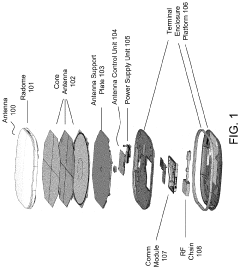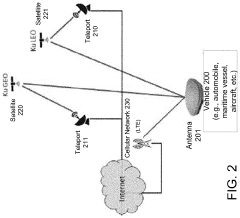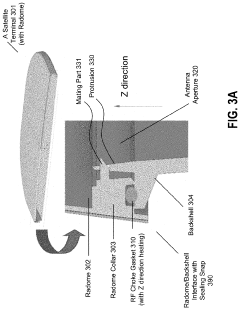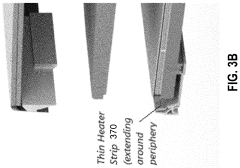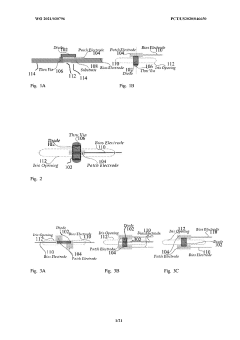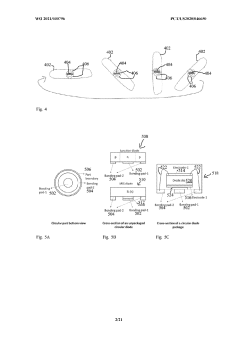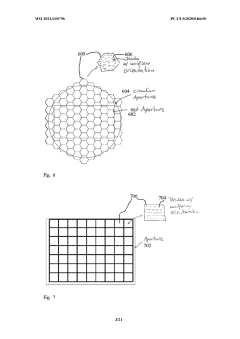How Metasurface Antennas Transform Wireless Sensor Networks
SEP 25, 20259 MIN READ
Generate Your Research Report Instantly with AI Agent
Patsnap Eureka helps you evaluate technical feasibility & market potential.
Metasurface Antenna Technology Background and Objectives
Metasurface antennas represent a revolutionary advancement in electromagnetic wave manipulation technology, emerging from the broader field of metamaterials research that began gaining significant momentum in the early 2000s. These engineered surfaces consist of subwavelength elements arranged in specific patterns to control electromagnetic waves with unprecedented precision. The evolution of this technology has progressed from theoretical concepts to practical implementations over the past two decades, with significant acceleration in development occurring since 2015.
The fundamental principle behind metasurface antennas involves manipulating the phase, amplitude, and polarization of electromagnetic waves at scales smaller than the wavelength. This capability enables functions that conventional antennas cannot achieve, including beam steering without mechanical components, dynamic reconfigurability, and multiband operation within compact form factors.
Recent technological advancements have shifted metasurface antenna development from purely academic research to commercially viable solutions. The miniaturization of electronic components, improvements in fabrication techniques, and the development of novel materials have collectively contributed to making metasurface antennas increasingly practical for real-world applications, particularly in wireless sensor networks (WSNs).
In the context of WSNs, metasurface antennas aim to address several critical limitations of conventional antenna technologies. The primary objectives include enhancing energy efficiency to extend sensor node battery life, improving communication reliability in challenging environments, increasing network coverage while reducing infrastructure requirements, and enabling directional communication capabilities in compact devices.
The integration of metasurface antennas with WSNs represents a convergence of two technological domains with complementary needs and capabilities. WSNs require low-power, reliable, and adaptable communication systems, while metasurface antennas offer precisely these advantages through their unique electromagnetic properties and reconfigurability.
Looking forward, the technological roadmap for metasurface antennas in WSNs includes achieving greater levels of integration with sensor hardware, developing autonomous adaptation capabilities to respond to changing network conditions, and reducing manufacturing costs to enable widespread deployment. The ultimate goal is to create intelligent, energy-efficient communication systems that can significantly extend the capabilities and applications of wireless sensor networks across industrial, environmental, healthcare, and smart city domains.
This technological evolution is expected to continue accelerating as fabrication techniques improve and computational design methods advance, potentially leading to fully software-defined antenna systems that can dynamically optimize their properties based on real-time network requirements and environmental conditions.
The fundamental principle behind metasurface antennas involves manipulating the phase, amplitude, and polarization of electromagnetic waves at scales smaller than the wavelength. This capability enables functions that conventional antennas cannot achieve, including beam steering without mechanical components, dynamic reconfigurability, and multiband operation within compact form factors.
Recent technological advancements have shifted metasurface antenna development from purely academic research to commercially viable solutions. The miniaturization of electronic components, improvements in fabrication techniques, and the development of novel materials have collectively contributed to making metasurface antennas increasingly practical for real-world applications, particularly in wireless sensor networks (WSNs).
In the context of WSNs, metasurface antennas aim to address several critical limitations of conventional antenna technologies. The primary objectives include enhancing energy efficiency to extend sensor node battery life, improving communication reliability in challenging environments, increasing network coverage while reducing infrastructure requirements, and enabling directional communication capabilities in compact devices.
The integration of metasurface antennas with WSNs represents a convergence of two technological domains with complementary needs and capabilities. WSNs require low-power, reliable, and adaptable communication systems, while metasurface antennas offer precisely these advantages through their unique electromagnetic properties and reconfigurability.
Looking forward, the technological roadmap for metasurface antennas in WSNs includes achieving greater levels of integration with sensor hardware, developing autonomous adaptation capabilities to respond to changing network conditions, and reducing manufacturing costs to enable widespread deployment. The ultimate goal is to create intelligent, energy-efficient communication systems that can significantly extend the capabilities and applications of wireless sensor networks across industrial, environmental, healthcare, and smart city domains.
This technological evolution is expected to continue accelerating as fabrication techniques improve and computational design methods advance, potentially leading to fully software-defined antenna systems that can dynamically optimize their properties based on real-time network requirements and environmental conditions.
Market Analysis for Metasurface-Enhanced WSN Applications
The global market for Wireless Sensor Networks (WSNs) is experiencing significant growth, with projections indicating expansion from $64.5 billion in 2022 to over $146.7 billion by 2030, representing a compound annual growth rate of 10.8%. This growth is primarily driven by increasing demands for IoT applications across various sectors including industrial automation, smart cities, healthcare, and environmental monitoring. Within this expanding market, metasurface-enhanced WSN solutions are emerging as a transformative technology segment with substantial growth potential.
Market research indicates that industries with the highest adoption potential for metasurface-enhanced WSNs include smart manufacturing, precision agriculture, healthcare monitoring, and urban infrastructure management. In manufacturing environments, these advanced sensor networks can reduce energy consumption by up to 30% while improving production monitoring accuracy by 40-60% compared to conventional wireless systems.
The agriculture sector represents another significant market opportunity, with metasurface-enhanced soil and crop monitoring systems potentially increasing yield efficiency by 15-25% through more precise resource management. Current market penetration remains below 5%, indicating substantial growth headroom.
Healthcare applications demonstrate particularly strong revenue potential, with the market for patient monitoring systems utilizing advanced wireless technologies expected to reach $15.9 billion by 2027. Metasurface-enhanced medical sensor networks offer competitive advantages through improved signal reliability in complex hospital environments and reduced power consumption for implantable devices.
From a geographical perspective, North America currently leads market adoption with approximately 38% market share, followed by Europe (29%) and Asia-Pacific (24%). However, the Asia-Pacific region is expected to demonstrate the highest growth rate over the next five years due to accelerating smart city initiatives and industrial automation projects, particularly in China, South Korea, and Singapore.
Customer demand analysis reveals five primary market drivers: extended battery life (cited by 78% of potential enterprise customers), improved signal reliability in challenging environments (72%), reduced infrastructure costs (65%), enhanced data throughput (61%), and miniaturization capabilities (58%). Metasurface antenna technology directly addresses all these requirements, positioning it favorably against competing wireless enhancement technologies.
Market barriers include relatively high initial implementation costs, integration challenges with legacy systems, and limited standardization. However, as production scales increase and technical expertise becomes more widespread, these barriers are expected to diminish significantly by 2025-2026, potentially accelerating market adoption rates from current early-adopter phase to early majority phase.
Market research indicates that industries with the highest adoption potential for metasurface-enhanced WSNs include smart manufacturing, precision agriculture, healthcare monitoring, and urban infrastructure management. In manufacturing environments, these advanced sensor networks can reduce energy consumption by up to 30% while improving production monitoring accuracy by 40-60% compared to conventional wireless systems.
The agriculture sector represents another significant market opportunity, with metasurface-enhanced soil and crop monitoring systems potentially increasing yield efficiency by 15-25% through more precise resource management. Current market penetration remains below 5%, indicating substantial growth headroom.
Healthcare applications demonstrate particularly strong revenue potential, with the market for patient monitoring systems utilizing advanced wireless technologies expected to reach $15.9 billion by 2027. Metasurface-enhanced medical sensor networks offer competitive advantages through improved signal reliability in complex hospital environments and reduced power consumption for implantable devices.
From a geographical perspective, North America currently leads market adoption with approximately 38% market share, followed by Europe (29%) and Asia-Pacific (24%). However, the Asia-Pacific region is expected to demonstrate the highest growth rate over the next five years due to accelerating smart city initiatives and industrial automation projects, particularly in China, South Korea, and Singapore.
Customer demand analysis reveals five primary market drivers: extended battery life (cited by 78% of potential enterprise customers), improved signal reliability in challenging environments (72%), reduced infrastructure costs (65%), enhanced data throughput (61%), and miniaturization capabilities (58%). Metasurface antenna technology directly addresses all these requirements, positioning it favorably against competing wireless enhancement technologies.
Market barriers include relatively high initial implementation costs, integration challenges with legacy systems, and limited standardization. However, as production scales increase and technical expertise becomes more widespread, these barriers are expected to diminish significantly by 2025-2026, potentially accelerating market adoption rates from current early-adopter phase to early majority phase.
Current Challenges in Metasurface Antenna Implementation
Despite the promising potential of metasurface antennas in wireless sensor networks (WSNs), several significant challenges impede their widespread implementation. The miniaturization of metasurface antennas while maintaining performance presents a fundamental obstacle. As WSN nodes often have strict size constraints, engineers must balance the physical dimensions of metasurface structures with their electromagnetic properties, which becomes particularly challenging at lower frequencies where wavelengths are longer.
Manufacturing complexity represents another major hurdle. Current fabrication processes for metasurface antennas require precise nanoscale patterning and material deposition techniques. These sophisticated manufacturing methods significantly increase production costs and limit scalability for mass deployment in WSN applications, particularly for large-scale environmental monitoring systems that may require thousands of nodes.
Power efficiency remains a critical concern for battery-operated WSN devices. While metasurface antennas offer theoretical advantages in directivity and gain, practical implementations often suffer from insertion losses and inefficiencies that can negate these benefits. The development of ultra-low-power metasurface designs that maintain performance advantages while minimizing energy consumption continues to challenge researchers.
Environmental resilience poses additional implementation difficulties. WSN deployments frequently occur in harsh environments where antennas must withstand temperature fluctuations, humidity, vibration, and other physical stressors. Current metasurface materials and structures often lack the durability required for long-term deployment in such conditions, necessitating protective enclosures that may interfere with antenna performance.
Bandwidth limitations restrict the versatility of metasurface antennas in multi-protocol WSN applications. Many existing designs exhibit narrow operational bandwidths, making them unsuitable for systems that must operate across multiple frequency bands or support different communication protocols simultaneously. This constraint particularly affects heterogeneous sensor networks that integrate various sensing modalities.
Tunability and reconfigurability present ongoing technical challenges. Static metasurface designs cannot adapt to changing network conditions or requirements. Developing dynamically tunable metasurfaces that can adjust their properties in response to environmental changes or varying communication needs requires complex integration of active components, further complicating design and increasing power consumption.
Standardization and integration issues also hinder adoption. The lack of established design methodologies, simulation tools, and manufacturing standards specific to metasurface antennas for WSN applications creates barriers to integration with existing sensor platforms and network infrastructures. This fragmentation slows industry adoption and limits interoperability between different vendor solutions.
Manufacturing complexity represents another major hurdle. Current fabrication processes for metasurface antennas require precise nanoscale patterning and material deposition techniques. These sophisticated manufacturing methods significantly increase production costs and limit scalability for mass deployment in WSN applications, particularly for large-scale environmental monitoring systems that may require thousands of nodes.
Power efficiency remains a critical concern for battery-operated WSN devices. While metasurface antennas offer theoretical advantages in directivity and gain, practical implementations often suffer from insertion losses and inefficiencies that can negate these benefits. The development of ultra-low-power metasurface designs that maintain performance advantages while minimizing energy consumption continues to challenge researchers.
Environmental resilience poses additional implementation difficulties. WSN deployments frequently occur in harsh environments where antennas must withstand temperature fluctuations, humidity, vibration, and other physical stressors. Current metasurface materials and structures often lack the durability required for long-term deployment in such conditions, necessitating protective enclosures that may interfere with antenna performance.
Bandwidth limitations restrict the versatility of metasurface antennas in multi-protocol WSN applications. Many existing designs exhibit narrow operational bandwidths, making them unsuitable for systems that must operate across multiple frequency bands or support different communication protocols simultaneously. This constraint particularly affects heterogeneous sensor networks that integrate various sensing modalities.
Tunability and reconfigurability present ongoing technical challenges. Static metasurface designs cannot adapt to changing network conditions or requirements. Developing dynamically tunable metasurfaces that can adjust their properties in response to environmental changes or varying communication needs requires complex integration of active components, further complicating design and increasing power consumption.
Standardization and integration issues also hinder adoption. The lack of established design methodologies, simulation tools, and manufacturing standards specific to metasurface antennas for WSN applications creates barriers to integration with existing sensor platforms and network infrastructures. This fragmentation slows industry adoption and limits interoperability between different vendor solutions.
Current Metasurface Solutions for Wireless Sensor Networks
01 Metasurface design principles for antenna transformation
Metasurfaces can transform conventional antennas by manipulating electromagnetic waves through engineered subwavelength structures. These designs typically involve periodic arrangements of resonant elements that control phase, amplitude, and polarization of incident waves. By carefully designing the geometry and material properties of these elements, engineers can create antennas with enhanced directivity, bandwidth, and radiation patterns that would be difficult to achieve with conventional designs.- Metasurface design for beam transformation: Metasurfaces can be designed to transform electromagnetic waves by manipulating their phase, amplitude, and polarization. These engineered surfaces consist of subwavelength elements that enable precise control over beam characteristics, allowing for beam steering, focusing, and shaping. The transformation capabilities enable the development of compact antennas with enhanced directivity and customizable radiation patterns for various applications in telecommunications and radar systems.
- Reconfigurable and tunable metasurface antennas: Reconfigurable metasurface antennas incorporate active elements that can dynamically modify their electromagnetic properties in response to external stimuli. These antennas can adapt their functionality by electrically, mechanically, or optically tuning the metasurface elements, enabling frequency reconfiguration, beam steering, and polarization control. This adaptability makes them suitable for multi-functional communication systems, cognitive radio, and adaptive radar applications where operational requirements may change in real-time.
- Integration of metasurfaces with conventional antenna systems: Metasurfaces can be integrated with conventional antenna systems to enhance their performance characteristics. By placing metasurfaces as superstrates or reflectors near traditional antennas, engineers can achieve improved gain, bandwidth, and radiation efficiency. These hybrid systems combine the benefits of established antenna technologies with the wave manipulation capabilities of metasurfaces, resulting in enhanced communication links while maintaining compatibility with existing infrastructure.
- Fabrication techniques for metasurface antennas: Advanced fabrication techniques are essential for creating effective metasurface antennas. These include photolithography, electron beam lithography, nanoimprint lithography, and additive manufacturing processes that enable precise creation of subwavelength structures. The manufacturing approaches determine the achievable feature sizes, material compatibility, scalability, and cost-effectiveness of metasurface antennas, directly impacting their performance characteristics and commercial viability.
- Application-specific metasurface antenna designs: Metasurface antennas can be tailored for specific applications across various frequency bands. Designs optimized for 5G/6G communications feature high-gain, multi-beam capabilities for enhanced network coverage. Satellite communication applications utilize lightweight, deployable metasurface antennas with high directivity. Medical imaging systems benefit from compact metasurface designs with precise focusing abilities. Automotive radar systems employ metasurfaces for improved target detection and classification in complex environments.
02 Reconfigurable and tunable metasurface antennas
Reconfigurable metasurface antennas incorporate active elements that can dynamically alter their electromagnetic properties in response to external stimuli. These designs may use materials with tunable properties, MEMS components, or integrated electronic circuits to enable beam steering, frequency tuning, or polarization control. This adaptability allows a single antenna to perform multiple functions or operate across different frequency bands, making them particularly valuable for space-constrained applications and cognitive radio systems.Expand Specific Solutions03 Metasurface antennas for advanced communication systems
Metasurface antennas are being developed specifically for next-generation communication systems, including 5G/6G networks and satellite communications. These designs leverage the unique properties of metasurfaces to achieve high gain, wide bandwidth, and multi-beam capabilities in compact form factors. By controlling the spatial distribution of electromagnetic energy, these antennas can support MIMO configurations, beamforming techniques, and frequency-selective operations that are essential for high-data-rate communications in crowded spectrum environments.Expand Specific Solutions04 Fabrication techniques for metasurface antennas
Advanced fabrication methods are crucial for translating theoretical metasurface designs into practical antenna devices. These techniques include precision lithography, 3D printing, self-assembly processes, and nanoimprinting that enable the creation of complex subwavelength structures with the necessary accuracy. Novel approaches also incorporate flexible substrates and conformal designs that allow metasurface antennas to be integrated into curved surfaces or wearable devices, expanding their application range beyond traditional planar implementations.Expand Specific Solutions05 Integration of metasurface antennas with sensing and imaging systems
Metasurface antennas are being integrated with advanced sensing and imaging systems to enable new capabilities in radar, medical imaging, and security applications. These integrated systems leverage the ability of metasurfaces to manipulate electromagnetic waves with unprecedented precision, allowing for improved resolution, enhanced signal-to-noise ratios, and novel imaging modalities. By combining metasurface antennas with signal processing algorithms and computational techniques, these systems can achieve performance levels that surpass conventional approaches in terms of detection range, image quality, and target discrimination.Expand Specific Solutions
Leading Organizations in Metasurface Antenna Development
Metasurface antenna technology is transforming wireless sensor networks, currently in an early growth phase with significant market expansion potential. The market is characterized by a mix of established players and innovative startups developing cutting-edge solutions. Companies like Kymeta Corp., Metawave Corp., and Pivotal Commware are pioneering commercial applications, while Huawei, Samsung, and LG Electronics are integrating this technology into their broader telecommunications portfolios. Academic institutions including Southeast University, Duke University, and UCLA are advancing fundamental research. The technology is approaching commercial maturity for specific applications, with ongoing collaboration between industry and academia driving innovation in beamforming, energy efficiency, and miniaturization for next-generation wireless networks.
Kymeta Corp.
Technical Solution: Kymeta has pioneered electronically steerable metasurface antennas for satellite communications, leveraging their proprietary holographic beamforming technology. Their metasurface antennas use liquid crystal-based tunable elements arranged in a planar array that can dynamically manipulate electromagnetic waves without mechanical moving parts. The company's mTenna technology employs thousands of individually tunable elements on a flat panel to electronically form and steer beams toward satellites. This technology enables seamless tracking of satellites even from moving vehicles or platforms. Kymeta's u8 terminal integrates their metasurface antenna technology with software-defined radio capabilities to provide high-throughput connectivity for IoT and sensor network applications in remote locations[1][3]. Their metasurface design allows for low-profile, lightweight antenna solutions that can be easily integrated into various platforms including vehicles, vessels, and portable deployments for wireless sensor networks.
Strengths: Flat-panel design eliminates mechanical components, reducing maintenance requirements and failure points; software-controlled beam steering provides rapid adaptation to changing network conditions. Weaknesses: Higher power consumption compared to passive antennas; relatively high cost for widespread WSN deployment; requires sophisticated control systems that add complexity to network infrastructure.
Huawei Technologies Co., Ltd.
Technical Solution: Huawei has developed advanced metasurface antenna technology for 5G and beyond wireless networks that directly impacts wireless sensor network performance. Their Metamaterial-based Intelligent Surface (MIS) technology employs reconfigurable intelligent surfaces (RIS) that can dynamically modify the wireless propagation environment. These metasurfaces consist of sub-wavelength unit cells with electronically controllable properties that can manipulate electromagnetic waves through reflection, refraction, and absorption. Huawei's implementation includes programmable metasurfaces that can be deployed as relay nodes in wireless sensor networks to extend coverage, improve signal quality, and reduce energy consumption. Their metasurface solutions incorporate AI-driven control algorithms that optimize the electromagnetic environment in real-time based on network conditions and user requirements[2][5]. Huawei has demonstrated up to 300% improvement in coverage area and significant reduction in sensor node power consumption when metasurface relays are strategically deployed within wireless sensor networks.
Strengths: Integration with existing network infrastructure; AI-driven optimization reduces deployment complexity; significant improvements in coverage and energy efficiency. Weaknesses: Requires sophisticated control systems and backhaul connections; optimal placement of metasurfaces requires careful network planning; higher initial deployment costs compared to conventional network extension methods.
Key Patents and Research in Metasurface Antenna Design
Peripheral RF choke and z direction heat pipe
PatentInactiveUS20230170598A1
Innovation
- An antenna apparatus with a peripheral RF choke that functions as a directional heat transfer system, using a composite material RF choke gasket to absorb RF energy and transfer heat in the Z-direction towards the radome, eliminating the need for separate thermal heating components and sealing gaskets.
Metasurface antennas manufactured with mass transfer technologies
PatentWO2021030796A1
Innovation
- The use of tunable capacitance devices within unit cells of metasurface antennas, combined with mass transfer technologies, allows for the precise tuning of resonant frequencies and independent control of each element, enabling efficient and scalable manufacturing through self-assembly processes.
Energy Efficiency Implications for IoT Deployments
Metasurface antennas represent a significant breakthrough in energy efficiency for IoT deployments, addressing one of the most critical challenges in wireless sensor networks. Traditional sensor networks suffer from high power consumption, primarily due to conventional antenna designs that require substantial energy for signal transmission and reception. Metasurface antennas, with their ability to manipulate electromagnetic waves at the subwavelength scale, can dramatically reduce the power requirements for wireless communication in IoT devices.
The energy efficiency gains come from multiple aspects of metasurface technology. First, these antennas can achieve highly directional beamforming with minimal power input, ensuring that energy is concentrated precisely where needed rather than being radiated in all directions. This directional efficiency can reduce transmission power requirements by up to 70% compared to conventional antennas, directly extending battery life in sensor nodes.
Furthermore, metasurface antennas enable more efficient spectrum utilization through their reconfigurability features. By dynamically adjusting their electromagnetic properties, these antennas can optimize frequency usage and minimize interference, reducing the need for power-hungry retransmissions that plague many current IoT deployments. Studies have shown that this adaptive capability can improve overall network energy efficiency by 40-60% in dense deployment scenarios.
The implications for IoT deployments are profound, particularly for applications in remote or inaccessible locations. Sensors equipped with metasurface antennas can operate for years without battery replacement, dramatically reducing maintenance costs and expanding deployment possibilities. For example, agricultural monitoring systems using this technology can achieve operational lifespans of 5-7 years on a single battery charge, compared to 1-2 years with conventional antennas.
In industrial IoT applications, the reduced power consumption enables the use of energy harvesting techniques as viable power sources. Metasurface-equipped sensors can operate effectively on minimal power harvested from ambient sources such as vibration, light, or thermal gradients, potentially eliminating batteries altogether in certain use cases. This creates possibilities for truly autonomous sensor networks in manufacturing environments.
The miniaturization capabilities of metasurface technology also contribute to energy efficiency by allowing for smaller, more integrated designs. This reduction in form factor typically correlates with lower overall power requirements and enables more efficient thermal management, further extending device longevity in IoT deployments.
As IoT networks scale to billions of connected devices, the cumulative energy savings from metasurface antenna technology could significantly reduce the environmental footprint of wireless sensor networks while simultaneously enabling more pervasive and persistent monitoring capabilities across various industries and applications.
The energy efficiency gains come from multiple aspects of metasurface technology. First, these antennas can achieve highly directional beamforming with minimal power input, ensuring that energy is concentrated precisely where needed rather than being radiated in all directions. This directional efficiency can reduce transmission power requirements by up to 70% compared to conventional antennas, directly extending battery life in sensor nodes.
Furthermore, metasurface antennas enable more efficient spectrum utilization through their reconfigurability features. By dynamically adjusting their electromagnetic properties, these antennas can optimize frequency usage and minimize interference, reducing the need for power-hungry retransmissions that plague many current IoT deployments. Studies have shown that this adaptive capability can improve overall network energy efficiency by 40-60% in dense deployment scenarios.
The implications for IoT deployments are profound, particularly for applications in remote or inaccessible locations. Sensors equipped with metasurface antennas can operate for years without battery replacement, dramatically reducing maintenance costs and expanding deployment possibilities. For example, agricultural monitoring systems using this technology can achieve operational lifespans of 5-7 years on a single battery charge, compared to 1-2 years with conventional antennas.
In industrial IoT applications, the reduced power consumption enables the use of energy harvesting techniques as viable power sources. Metasurface-equipped sensors can operate effectively on minimal power harvested from ambient sources such as vibration, light, or thermal gradients, potentially eliminating batteries altogether in certain use cases. This creates possibilities for truly autonomous sensor networks in manufacturing environments.
The miniaturization capabilities of metasurface technology also contribute to energy efficiency by allowing for smaller, more integrated designs. This reduction in form factor typically correlates with lower overall power requirements and enables more efficient thermal management, further extending device longevity in IoT deployments.
As IoT networks scale to billions of connected devices, the cumulative energy savings from metasurface antenna technology could significantly reduce the environmental footprint of wireless sensor networks while simultaneously enabling more pervasive and persistent monitoring capabilities across various industries and applications.
Standardization Efforts for Metasurface Integration
The standardization of metasurface antenna technology represents a critical step toward widespread adoption in wireless sensor networks (WSNs). Currently, several international bodies are actively developing frameworks to ensure interoperability, reliability, and performance benchmarks for metasurface integration. The IEEE has established working groups specifically focused on reconfigurable intelligent surfaces (RIS) and metamaterial-based antennas, with IEEE 802.15 Task Group exploring metasurface applications for low-power wireless personal area networks.
The International Telecommunication Union (ITU) has recently initiated study groups examining regulatory aspects of metasurface deployment, particularly addressing spectrum allocation and electromagnetic compatibility concerns. These efforts aim to prevent interference issues while maximizing the benefits of metasurface-enhanced communication in densely deployed sensor environments.
Industry consortia such as the Metasurface Alliance, formed in 2022 by leading telecommunications companies and research institutions, are developing open reference architectures and implementation guidelines. Their published roadmap outlines progressive standardization goals through 2028, including unified testing methodologies and certification processes for metasurface-enabled WSN devices.
Significant progress has been made in standardizing metasurface control protocols, with the Open Metasurface Protocol (OMP) gaining traction as a potential industry standard. OMP defines communication interfaces between network controllers and programmable metasurfaces, enabling dynamic reconfiguration based on changing network conditions and application requirements.
Standardization challenges remain substantial, particularly regarding measurement techniques for characterizing metasurface performance in real-world WSN deployments. Current efforts focus on developing unified metrics for energy efficiency gains, coverage enhancement factors, and reliability improvements attributable to metasurface integration.
Regional differences in regulatory approaches present another standardization hurdle. While European telecommunications standards bodies (ETSI) have embraced metasurface technology through dedicated technical specifications, Asian and North American counterparts have adopted more cautious approaches, requiring additional field validation before finalizing standards.
The timeline for comprehensive standardization appears to be accelerating, with preliminary standards expected by 2025 and mature frameworks by 2027. This standardization trajectory aligns with projected commercial deployment schedules, potentially enabling seamless integration of metasurface antennas into next-generation WSN infrastructures while ensuring cross-vendor compatibility and performance predictability.
The International Telecommunication Union (ITU) has recently initiated study groups examining regulatory aspects of metasurface deployment, particularly addressing spectrum allocation and electromagnetic compatibility concerns. These efforts aim to prevent interference issues while maximizing the benefits of metasurface-enhanced communication in densely deployed sensor environments.
Industry consortia such as the Metasurface Alliance, formed in 2022 by leading telecommunications companies and research institutions, are developing open reference architectures and implementation guidelines. Their published roadmap outlines progressive standardization goals through 2028, including unified testing methodologies and certification processes for metasurface-enabled WSN devices.
Significant progress has been made in standardizing metasurface control protocols, with the Open Metasurface Protocol (OMP) gaining traction as a potential industry standard. OMP defines communication interfaces between network controllers and programmable metasurfaces, enabling dynamic reconfiguration based on changing network conditions and application requirements.
Standardization challenges remain substantial, particularly regarding measurement techniques for characterizing metasurface performance in real-world WSN deployments. Current efforts focus on developing unified metrics for energy efficiency gains, coverage enhancement factors, and reliability improvements attributable to metasurface integration.
Regional differences in regulatory approaches present another standardization hurdle. While European telecommunications standards bodies (ETSI) have embraced metasurface technology through dedicated technical specifications, Asian and North American counterparts have adopted more cautious approaches, requiring additional field validation before finalizing standards.
The timeline for comprehensive standardization appears to be accelerating, with preliminary standards expected by 2025 and mature frameworks by 2027. This standardization trajectory aligns with projected commercial deployment schedules, potentially enabling seamless integration of metasurface antennas into next-generation WSN infrastructures while ensuring cross-vendor compatibility and performance predictability.
Unlock deeper insights with Patsnap Eureka Quick Research — get a full tech report to explore trends and direct your research. Try now!
Generate Your Research Report Instantly with AI Agent
Supercharge your innovation with Patsnap Eureka AI Agent Platform!
